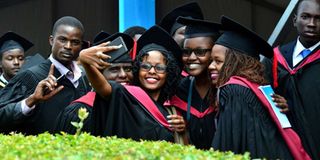Open university will allow more to access education

University of Nairobi graduands take a selfie during a graduation ceremony held on September 22, 2017.
What you need to know:
- The Commission for University Education (CUE) has weighed in and developed stringent regulations to standardise the sector and taken drastic decisions on universities. On his part, the Education Cabinet Secretary has issued a directive stopping the establishment of campuses.
- We also need to learn from the experiences of South Africa. The University of South Africa (Unisa) is defined as a mega university with over 480,000 students.
- Already Kenya sits in the best position to attract many students to an ODL university because of its strategic position in the East African region as an economic hub. With proper planning, an ODL university should develop a strong staff development policy that would ensure superior pedagogical skills for teaching of a diverse student community.
The past three decades have seen a major expansion and transformation of university education in Kenya. We have grown from one university in 1984 to 23 public universities and 10 constituent colleges in 2016. An additional 36 private universities have been licensed to operate in the country. Despite these developments in university education, we are yet to solve problems of access, affordability and quality.
Our universities suffer from, among other things, limited funding, de-motivated staff and lack of a research culture. Due to limited funding, universities have had to find alternative ways of meeting their financial obligations. This has, in some cases, led to crude competition for students through establishment of many campuses all over.
The Commission for University Education (CUE) has weighed in and developed stringent regulations to standardise the sector and taken drastic decisions on universities. On his part, the Education Cabinet Secretary has issued a directive stopping the establishment of campuses.
These measures are meant to ensure quality and they are, by all means, welcome. Indeed, as a major player in this sector, I have to admit that we have to do everything possible to ensure quality while opening up accessibility to educational opportunities.
It is no longer useful to moan, but dialogue with all players in making sure that we streamline the sector. But more importantly, there is a need to think about more innovative ways of delivering quality education services that are affordable. The best bet for Kenya is the speedy establishment of the National Open University of Kenya (NOUK). It is a fact that there has been more talk on establishment of this university than action.
In a conference organised by the Commission for University Education recently, it was revealed that the idea of an open university has been with us for over 20 years ago.
Tanzanians bought into the idea and established the Open University of Tanzania (OUT) in 1994. OUT became the first university in the whole of East African region to fully offer educational programmes on open and distance learning mode.
Currently, the Open University of Tanzania has more students than those in all the other universities in Tanzania!
We also need to learn from the experiences of South Africa. The University of South Africa (Unisa) is defined as a mega university with over 480,000 students.
In essence, it has more students than all students in Kenyan universities put together. Established in 1918, Unisa is a reputable open and distance learning institution, which offers internationally accredited qualifications.
IDEAL OPPORUNITY
Situated on the beautiful Muckleneuk Ridge in Pretoria, the campus is an imposing monument with centres all over the world and with students from over 130 countries. It is South Africa’s most productive institution which accounts for 12.8 per cent of all degrees conferred by the country’s 23 public universities.
In universities’ ranking of the last 10 years, Unisa has often been rated among the top 10 best universities in the Africa. It is true that a number of our universities have small units offering open and distance learning in Kenya, but they will never come closer to satisfying the demand for a flexible mode of learning.
We need a university dedicated purely to offering open and distance learning (ODL) and allow it to take its rightful place among the best ODL universities in the world.
An open university presents an ideal opportunity for internationalisation since it attracts students and faculty from all over the world.
Such a university becomes a meeting point and a destination for scholars from the world over.
An ODL university has the opportunity to develop a respectable research profile through promoting academic exchanges, research dissemination and partnerships worldwide because of its nature.
Already Kenya sits in the best position to attract many students to an ODL university because of its strategic position in the East African region as an economic hub. With proper planning, an ODL university should develop a strong staff development policy that would ensure superior pedagogical skills for teaching of a diverse student community.
It would enable Kenya to play a modest role in contributing to the resolution of global problems of providing educational access to “the masses”.
Modern technology has made it unnecessary to prioritise the traditional face to face classes. Teaching can now be done through experts situated anywhere in the world.
This drastically reduces the operational costs in provision of educational services. The shortage of staff that is currently afflicting some disciplines in our universities cannot afflict an ODL university.
It will be able to tap from resources that exist from all over the world. Millions of people throughout the world are looking for opportunities for further education that is flexible and affordable and Kenya cannot afford to continue procrastinating on establishment of an ODL university.




